Digital power is not a monolithic technology, but a common element in almost all digital power converters is a communication bus, usually based on the PMBus protocol. This FAQ delves into the numerous hardware embodiments and variations of digital power. Part 2 will dig into the operation of the PMBus protocol and the associated SMBus transport layer. Part three will review the benefits of using power converters that employ digital power technology.
One embodiment of digital power is a management IC that can perform various monitoring and control functions but is not embedded in a power converter. A second variation is to embed digital communication in a power converter with an analog control loop. This is often referred to as a “digital wrapper.” Another variation is to add an outer digital control loop to supplement a fast analog control loop. Finally, there are power converters that use totally digital control, eliminating the analog control loop altogether.
Digital power benefits
By using advanced control algorithms, digital power can dynamically change the control parameters and adapt the system behavior to input and load changes. In addition, many key components of a power supply can now be consolidated into one chip.

Digital power supplies provide versatility in optimizing efficiency at multiple operating points. For the PFC boost converter, switching losses can be reduced at lighter loads by operating the converter at a lower switching frequency. Due to the lighter load, the magnetics will still be able to handle the lower switching frequencies. If an interleaved PFC converter is implemented, one phase can be turned OFF at light loads. Similarly, for a phase-shifted full-bridge converter, extra switching losses can be eliminated at light loads by turning OFF switching of the synchronous MOSFETs and using the body diodes instead.
Another example is in a buck converter application. Synchronous buck converters are typically preferred for high current outputs. However, the use of the synchronous MOSFET causes circulating currents at light loads, causing higher losses. Therefore, the synchronous/free-wheeling MOSFET in a buck converter can be disabled when the converter operates in Discontinuous Current mode.
Many new techniques can be implemented in the digital domain that are almost impossible or too complex to be implemented in the analog domain. One example is the implementation of non-linear control systems. It is also possible to change the control loop in real-time, adapting the system’s behavior to dynamically change the system operating conditions, for instance, during changing input and output load conditions.
Digital power management ICs
Digital power management ICs are the most basic form of digital power. Devices are available to implement a variety of power system management functions such as digital supervisors that provide enhanced monitoring and control of individual DC/DC converters, hot-swap controllers with digital monitoring, system power management ICs with PMBus interfaces, and more.
The D44TL1A0 from Vicor is a digital power system supervisor which provides a communication interface between a host processor and up to four of the company’s ChiP BCM Bus Converter Modules. The D44TL1A0 communicates with a system controller via a PMBus compatible interface. Acting as a communication bridge, the supervisor communicates with up to four BCMs over isolated UART interfaces. Through the D44TL1A0, the host processor can configure, set protection limits, and monitor each BCM.
Maxim Integrated Products’ MAX16545B/C is a circuit-breaker protection IC with an integrated low-resistance MOSFET and lossless current-sense circuitry featuring PMBus/SMBus telemetry with extensive status monitoring and reporting. The IC is designed to provide the optimum solution for distribution, control, monitoring, and protection of the system’s 12V power supply. An internal LDO provides the bias supply voltage for the protection IC. Three methods of overcurrent protection are provided. Programmable moderate OCP level allows surge currents for a limited time. User-selectable severe OCP level provides a fast disconnect if a current exceeding the severe OCP threshold is detected. An additional fixed high shutdown OCP level provides instantaneous disconnect to protect the device further.
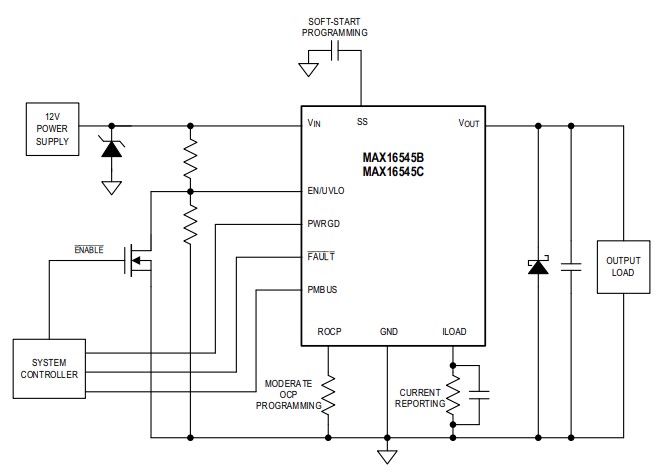
Targeting hot-swap applications, Analog Devices offers the ADM1075, a negative voltage, hot-swap controller with constant power foldback and high accuracy digital current and voltage measurement that allows boards to be safely inserted and removed from a live −48Vdc backplane. The part provides precise and robust current limiting and protection against both transient and non-transient short circuits and overvoltage and undervoltage conditions.
Current, voltage, and power measurements can be initiated by a PMBus command or can be set up to run continuously. The user can read the latest conversion data whenever it is required. A power accumulator is also provided to report total power consumed in a user-specified period (total energy).
The LM25056A from Texas Instruments combines high-performance analog with digital technology and a PMBus interface to accurately measure the operating conditions of electrical systems, including computing and storage blades connected to a backplane power bus. The device continuously supplies real-time power, voltage, current, and temperature data to the system management host.
Digital wrappers
Digital wrappers are offered in various formats, from very simple power converter devices to complex system controllers. The IR38063 PMBus SupIRBuck™ from Infineon is a fully integrated DC/DC regulator with I2C/PMBus interface. The IR38063 can be comprehensively configured via PMBus with the configuration stored in internal memory. In addition, PMBus commands allow run-time control, fault status, and telemetry. The IR38063 can also operate as a standard analog regulator without any programming and can provide current and temperature telemetry in an analog format.
Microchip offers its Digitally Enhanced Power Analog (DEPA) controllers that contain analog control loops with digital oversight using analog references, amplifiers, and PWM generators to regulate output while configuring, monitoring, measuring, and dynamically adjusting that performance with an embedded 8-bit microcontroller (MCU). This allows the system to report telemetry, make operating adjustments on the fly, and respond to faults with customized, application-specific code. Without this added integration, flexible, robust designs could require separate chips to regulate the output, adjust the regulator operation, measure the results, and communicate the information outside the system.
Digital and analog hybrid controllers
The STNRGPF01 is a digital configurable ASIC developed by STMicroelectronics, which can drive up to three channels in an interleaved PFC for industrial applications. The STNRGPF01 implements mixed-signal (analog/digital) control. The inner current loop is performed by hardware, and a digital PI controller performs the outer voltage loop. The device performs cascaded control for voltage and current loops to regulate the output voltage by acting on the total average inductor current. The analog section ensures cycle-by-cycle current regulation, while digital control manages the non-time-critical operations.
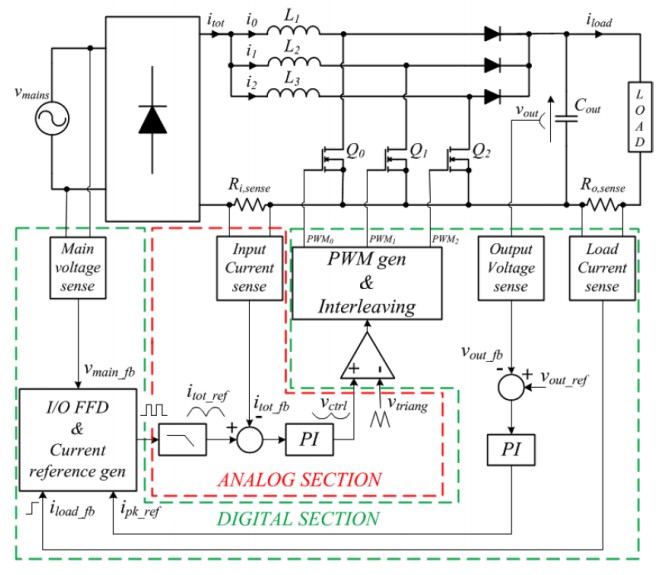
The STNRGPF01 implements a flexible phase shedding strategy that enables the correct number of PFC channels based on the actual load condition. With this function, the STNRGPF01 is always able to guarantee the highest power efficiency across a wide range of load current requirements.
Microchip offers its core independent peripheral (CIP) hybrid power controllers based on its PIC microcontrollers (MCUs). These MCUs implement a hybrid approach to power control by combining the flexibility of analog and digital peripherals that can be configured at runtime to enable the MCU to control various topologies. Since CIPs are designed to operate independently from the core, they free up the Central Processing Unit (CPU) to perform communication and coordination tasks. A single controller can manage up to four independent power conversion stages. This solution is designed for managing smart solid-state lighting, advanced dimming for automotive and building automation, battery charging, multistage power sequencing, and smart power applications for the Internet of Things.
Pure digital controllers
Texas Instruments and Infineon offer pure digital controllers incorporating ARM microcontrollers. The UCD3138 is a digital power supply controller from Texas Instruments, offering high integration and performance levels in a single-chip solution. The flexible nature of the UCD3138 makes it suitable for a wide variety of power conversion applications. In addition, multiple peripherals inside the device have been specifically optimized to enhance the performance of AC/DC and isolated DC/DC applications and reduce the solution component count in the IT and network infrastructure space.
At the core of the UCD3138 controller are the digital control loop peripherals, also known as Digital Power Peripherals (DPPs). Each DPP implements a high-speed digital control loop consisting of a dedicated Error Analog-to-Digital Converter (EADC), a PID-based 2-pole/2-zero digital compensator, and DPWM outputs with 250-ps pulse width resolution. The device also contains a 12-bit, 267-ksps general-purpose ADC with up to 14 channels, timers, interrupt control, PMBus, and UART communications ports.
The XDPP1100 is Infineon’s highly integrated and programmable digital power supply controller. This device offers an advanced power control solution for 48V DC/DC power applications with isolated topologies. The XDPP1100 device features many optimized power processing blocks and pre-programmed peripherals to enhance the performance of isolated DC/DC converters, reduce external components, and minimize firmware development effort.
The controller also provides an accurate telemetry PMBus interface for system communication, advanced power conversion, and monitoring. Integrated current sensing capability and compact chip size (24-pin 4 mm2) can greatly reduce the solution size by eliminating various external components. The XDPP1100 includes a high-performance analog front end, state machine based digital control loop, and an Arm Cortex M0.
As shown, digital power is a broad area of technology with numerous interpretations and embodiments. One common element across most of the variations is the use of PMBus communication. The next FAQ in this series will consider “Digital power management and PMBus moving into the future.”
References:
Benefits of Digital Control for Power Conversion, Microchip Technology
Power Management Bus, Wikipedia
What is Digital Power?, Renesas Electronics

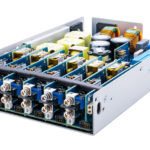

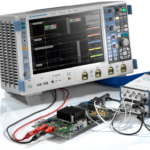
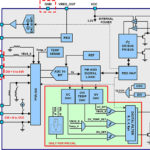


Leave a Reply